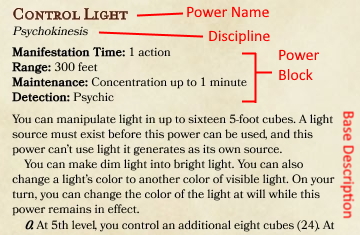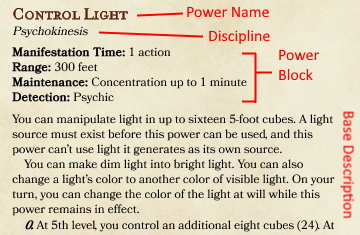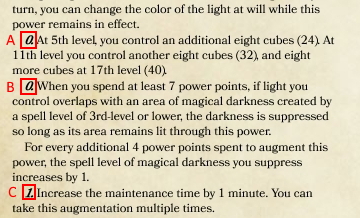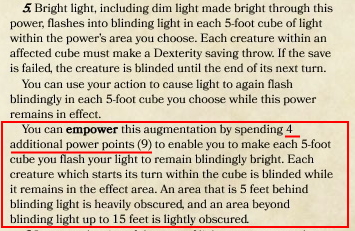In this post, we’re going to break down how to read a psionic power description block and how you can use that to manifest your powers. For this purpose, we’ll be looking at the control light power.

The first line of the power is its name, followed by which of the five psionic disciplines the power belongs to. Just like how spells are split between spell schools, powers are split between disciplines. A discipline informs you how the power interacts with its target. A psychokinetic power, for instance, utilizes force or directly alters the world.
The power block details the game information of a power in the same way a spell block details the information for a spell. However, there are certain, critical, differences between the spell block and the power block.
Manifestation Time is the equivalent to a spell’s Casting Time. It tells you the action you need to manifest the power. If it requires a reaction, then it also tells you under which circumstances you can take that reaction.
Range is very similar to the range of a spell, but their is one key difference. Unlike a spell, a power doesn’t have its own energy to maintain its effect – it’s dependent on the manifester. Unless the power indicates otherwise, ifs effects cease the moment those effects fall outside the range of the power. For a single target power, the power ends once the target is outside the range, while an area of effect power only has the effect area outside its range suppressed.
Maintenance functions in a similar way to the Duration of a spell, but operates a bit differently. An “instantaneous” power, for instance, has a maintenance of “None” because it can’t be maintained. Most powers can be maintained, and will nearly always require concentration.
Another element that separates spell duration from power maintenance, is that while a spell ends when its duration expires, a manifester can choose to continue to maintain a power beyond its maintenance time. The moment this happens, the manifester is affected by the psychic strain condition, which will deal damage to the manifester each turn it maintains the power and whenever it attempts to manifest a new power.
Detection operates somewhat like a spell’s Components. Powers don’t require incantation or material components. Instead, they are exertions of will, but these exertions have tells which knowledgeable creatures can recognize as the manifestation of a power. With control light, we only have the “psychic” detection. The psychic detection is possessed by most powers, and is the gathering and shaping of the psionic energies to manifest the power. Other detections are more visible, such as creating glow effects or altering the target in obvious ways.
Description

Looking back at our excerpt, we begin the power’s description, starting with the base part of the description.
This section contains the rules that apply to all instances of the power, regardless of augmentation. For control light, we see that “a light source must exist” and that “it can’t use light it generates as its own source.” We also know that it affects 5-foot cubes.
Also within this base description is the core power or at-will effect, which is the effect that is equivalent to a cantrip. All powers have a cantrip-level effect, and like cantrips can always be used regardless of how many power points the manifester has remaining. For control light, its core power effect allows you to make existing dim light bright or to change the color of a light.
Augmentations

Next, we’ll cover power augmentationsand how to spend power points to manifest a power beyond the core and base functionality.
I’ve marked up the image to the right to detail the different kinds of augmentation to look out for.
Augmentation type A is found on several powers, especially damage-oriented powers. It is the cantrip scaling component of such powers. As your manifester gains character levels, your power automatically gets stronger. The augmentation cost, is “0” meaning you don’t have to expend a single power to get it. However, in some cases, there are criteria that have to be met to get it, leading us to…
Augmentation type B is another 0 cost augmentation, but unlike the cantrip scaling effect, it has requirements that must first be met. For control light, this augmentation only kicks in when you spend at least 7 power points. While the augmentation is free, until you spend enough power points on other augmentations, the effect isn’t applied. Also for control light, we see that this augmentation also gets better when you manifest the power with more power points on this power.
Augmentation type C is the final kind of power augmentation. This is where you spend power points to sculpt the power as you manifest it. Each is listed with a cost (1 power point in the excerpt) that you must pay, followed by what the augmentation does. In the sample, it a simple maintenance time extension. The augmentation also tells us that you can take it multiple times. Each additional time requires you to pay the cost of the augmentation again. So if you wanted to maintain control light for 3 minutes, you would have to spend 2 power points to increase its base 1 minute maintenance by 2 more minutes.
Empowerments

This type of augmentation sometimes has an additional option to further shape the power. This option is called an “Empowerment” which empowers the augmentation. In order to empower the power in this way, you must first take the augment, and then you must spend additional power points as indicated in the description. In this case, you need to spend 5 power points on the augmentation and 4 additional power points for the empowerment, for a total of 9 power points. The description will list the total cost for the augmentation and that specific empowerment, provided the empowerment can’t be taken multiple times.
There are some cases when an empowerment is automatic when you take the augmentation. Like the automatic augmentations, an automatic empowerment doesn’t cost you additional power points for its effect, but it does require that you spend power points on other augmentation or empowerments to tap its effects.
Spending Power Points.
In order to manifest a power beyond the core function, you need to spend power points on augmentations and empowerments. You are free to pick any augmentation and its empowerments, unless the description says otherwise.
However, you can never spend more power points on a single manifestation than your class allows. For full manifesters this is equal to your class level. For half and third manifesters its half or one third your class level, rounded up. For instance, a 9th-level transcendent could spend up to 5 power points on a single power.
Psychic classes are designed around a short rest resource pool which restricts how many power points you can tap at a given time, so before you consider manifesting the strongest version of your power or to enable every option you can afford, you need to plan out how your power point reserve will see you until the next rest.
You want to make the most of your power point reserve, so it’s best to leverage the sculptability of psionic powers and manifest the expression that achieves exactly what you need it to achieve and no more. By their nature, psionic powers are more versatile than spells, but that versatility can lead to overspending if you aren’t careful.